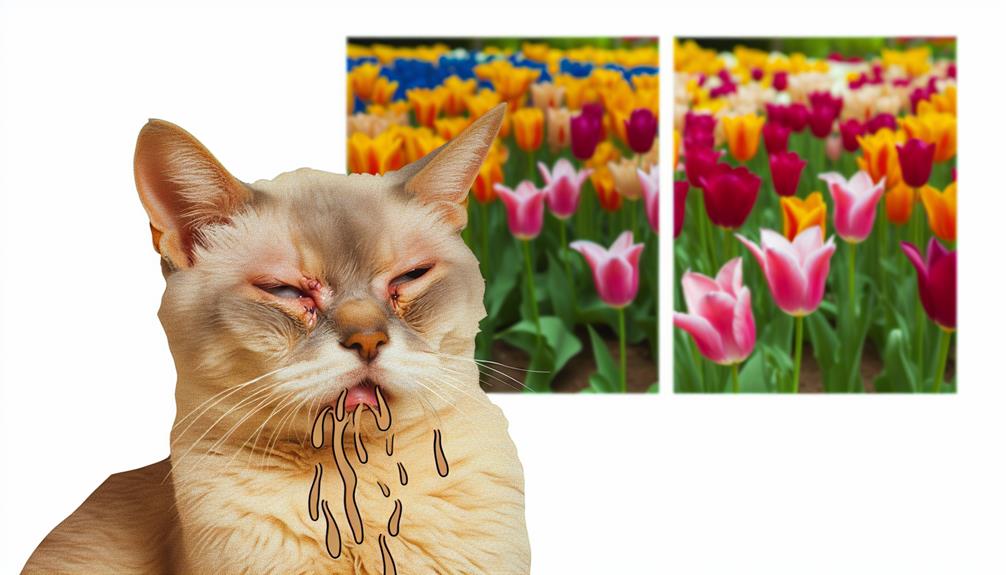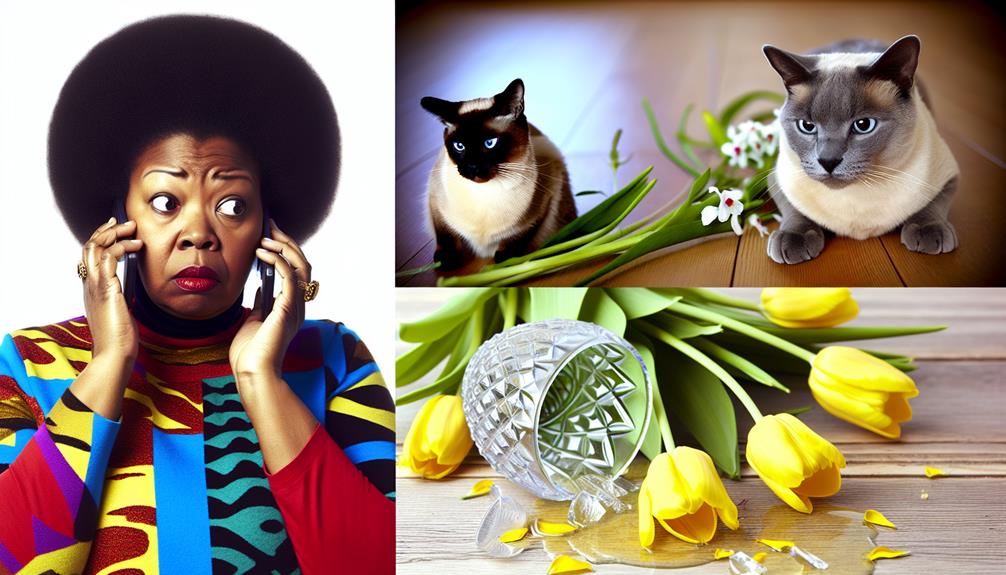If you've got a curious feline and a love for tulips, you might be wondering if your favorite flowers pose any danger to your pet. Tulips, with their vibrant colors and alluring scent, hide a toxic secret that could harm your cat. The compounds tulipalin A and B, found in every part of the plant, can cause serious health issues like vomiting, diarrhea, and lethargy. But what exactly should you do if your cat has nibbled on a tulip? Understanding the signs and immediate actions to take could be essential.
Understanding Tulip Toxicity
Tulip toxicity in cats arises primarily from the presence of alkaloid compounds known as tulipalin A and tulipalin B. These substances are naturally occurring in tulips and serve as a defense mechanism against herbivores. However, they pose a significant risk to your feline friends. When it comes to tulip care and ensuring feline safety, understanding the mechanisms of these toxic compounds is vital.
If you suspect tulip ingestion, you'll need to monitor for symptoms like vomiting, diarrhea, and hypersalivation. These are often the first signs of tulip toxicity and should prompt immediate veterinary consultation. The diagnostic approach typically involves a thorough clinical history and physical examination. Your vet may run blood tests to assess the cat's organ function and identify any deviations that could indicate toxicity.
For those who enjoy tulip care but also prioritize feline safety, preventive measures are essential. Consider placing tulips in areas inaccessible to cats or opting for non-toxic floral alternatives. Additionally, it's advisable to educate yourself on the entire plant, as tulipalin A and B are present in all parts of the tulip, including the petals, leaves, and bulb.
Toxic Compounds in Tulips
When considering tulips' impact on feline health, you should be aware of harmful alkaloids like tulipalin A and B present in the plant. These compounds can induce severe gastrointestinal distress, drooling, and even central nervous system complications in cats. As a result, implementing stringent safety measures to prevent your pet's exposure is essential.
Harmful Alkaloids Presence
One of the primary reasons tulips are dangerous to cats lies in the presence of harmful alkaloids, specifically tulipalin A and tulipalin B. These compounds are integral to the alkaloid chemistry of tulips, and they pose a significant threat due to feline sensitivity. Cats are particularly vulnerable to these toxic substances, which are found throughout the tulip plant, from bulbs to petals.
Understanding the risks involves examining the biochemical interactions between tulip alkaloids and feline physiology:
- Alkaloid Absorption: Upon ingestion, tulipalin A and B are rapidly absorbed in the gastrointestinal tract, leading to swift systemic distribution.
- Metabolic Pathways: These alkaloids interfere with essential metabolic pathways in cats, causing disruptions at the cellular level.
- Sensitivity Thresholds: Even minimal exposure can elicit a toxic response due to the heightened sensitivity of cats to these compounds.
In diagnosing tulip poisoning, a veterinarian would consider the presence of these alkaloids through a combination of clinical signs and possibly laboratory tests. Tulipalin A and B are distinctive markers that can guide the diagnostic approach. By understanding the specific alkaloid chemistry and its implications for feline sensitivity, you can grasp why tulips are a hazardous plant for cats.
Potential Poisonous Effects
In evaluating the potential poisonous effects of tulip compounds on cats, it is vital to focus on the toxicological profile of tulipalin A and B. These glycosides are concentrated primarily in the bulbs but are also present in other parts of the plant. Upon ingestion, these compounds can cause a range of toxic responses in felines.
Here's a brief overview of the symptoms, severity, and onset time associated with tulipalin A and B ingestion:
| Symptom | Severity | Onset Time |
|---|---|---|
| Vomiting | Moderate to High | Within a few hours |
| Diarrhea | Moderate | Within 12-24 hours |
| Lethargy | High | Immediate to 24 hours |
Tulipalin A and B disrupt cellular integrity and enzyme function, leading to gastrointestinal upset and systemic toxicity. Vomiting and diarrhea are your cat's first defense and indicate immediate distress. More severe cases may present with lethargy, indicating systemic involvement.
Understanding these toxic compounds is essential for tulip care and safe gardening, especially if you have curious cats around. By being aware of the dangers, you can take preventative measures to guarantee your garden remains a safe haven for all its inhabitants.
Safety Measures Needed
Recognizing the toxic potential of tulipalin A and B is just the beginning; implementing effective safety measures is paramount to protect your feline companions. Tulipalin A and B, found in tulips, can cause severe gastrointestinal distress and other symptoms in cats. To mitigate these risks, follow stringent tulip care practices and guarantee vigilant cat supervision.
You must adopt a preventive approach, focusing on minimizing your cat's exposure to these harmful compounds. Consider the following steps:
- Remove Tulips from Home: The most effective measure is to eliminate tulips from your home entirely. This removes any risk of accidental ingestion.
- Secure Tulip Areas: If removing tulips isn't feasible, guarantee that areas where tulips are planted or displayed are inaccessible to your cats. Use physical barriers or strategic placement.
- Constant Monitoring: Regularly supervise your cat, especially in areas where tulips are present. Immediate intervention can prevent potential poisoning.
Incorporating these measures into your daily routine is essential for the well-being of your feline friends. By adopting proper tulip care and guaranteeing meticulous cat supervision, you can greatly reduce the risk of tulipalin toxicity and maintain a safe environment for your pets.
Symptoms of Tulip Poisoning

When your cat ingests tulips, you'll likely notice symptoms such as hypersalivation, vomiting, and diarrhea. Behavioral changes, including lethargy and disorientation, are also common indicators of toxicity. Immediate care involves inducing vomiting and administering activated charcoal, but always consult your veterinarian for precise treatment.
Common Poisoning Signs
Symptoms of tulip poisoning in cats can manifest rapidly and may include gastrointestinal distress such as vomiting and diarrhea, which are often the earliest indicators of ingestion. These symptoms are your first clue that your feline friend might have ingested part of a tulip.
To effectively monitor your cat's behavior and guarantee plant safety in your home, be aware of the following common poisoning signs:
- Hypersalivation: An increase in drooling is a classic sign of oral irritation caused by the toxins in tulips.
- Lethargy: A poisoned cat may appear unusually tired or weak, indicating systemic toxicity affecting their overall health.
- Ataxia: This refers to a lack of coordination, causing your cat to stumble or have difficulty walking, which is a serious neurological sign of tulip poisoning.
When you observe these symptoms, it's essential to seek veterinary care immediately. Diagnostically, your vet may perform blood tests to assess liver and kidney function, as well as an examination of the oral cavity for signs of irritation. Prompt identification and treatment are critical for your cat's recovery. Always practice plant safety by keeping tulips out of reach to prevent accidental ingestion and guarantee your cat's well-being.
Behavioral Changes Observed
Behavioral changes often present early in cases of tulip poisoning and can provide essential diagnostic clues. When your cat interacts with tulips, you might notice a sudden shift in their usual cat behavior. Look for signs of hyper-salivation, agitation, or unusual vocalizations. These changes are your cat's response to ingesting toxins like tulipalin A and B, which are present in all parts of the tulip plant.
Your cat might also exhibit signs of gastrointestinal distress. Vomiting, diarrhea, and a noticeable decrease in appetite are common symptoms. These manifestations are direct results of the body's attempt to expel the toxic substances ingested during tulip interactions. Additionally, you may observe lethargy or signs of depression. This behavioral downturn often indicates a more severe toxic reaction, requiring immediate veterinary attention.
Another essential behavioral change is ataxia, or uncoordinated movements, which can suggest neurological involvement. If your cat starts stumbling, appears disoriented, or shows signs of muscle tremors, these symptoms are significant. Recognizing these behavioral alterations early can be vital for effective diagnosis and subsequent treatment. Always keep an eye out for these signs if you suspect your cat has been in contact with tulips.
Immediate Care Steps
In cases of suspected tulip poisoning, promptly initiating immediate care steps can be essential for your cat's recovery. Recognizing the symptoms early guarantees that emergency response measures are effective. Look for clinical signs such as vomiting, excessive drooling, diarrhea, or lethargy. These symptoms are indicative of gastrointestinal distress caused by toxic compounds in tulips known as tulipalin A and B.
When you suspect tulip poisoning, follow these first aid steps:
- Remove Access to the Plant: Immediately isolate your cat from the tulip to prevent further ingestion.
- Induce Vomiting: Only if directed by a veterinarian, you may need to induce vomiting to expel the toxin. This step must be performed under professional guidance to avoid complications.
- Contact a Veterinarian: Call your vet or an emergency pet poison hotline for immediate advice. Rapid diagnostic measures may include blood tests and physical examinations to determine the extent of poisoning.
It's critical to act swiftly and precisely. Delayed treatment can exacerbate the toxic effects, leading to more severe symptoms or even fatality. Always keep emergency contacts handy and verify you know the location of the nearest veterinary clinic for urgent situations.
Diagnosing Plant Poisoning
When suspecting tulip toxicity in your cat, a systematic diagnostic approach is crucial to confirm plant poisoning. Start by observing clinical signs such as vomiting, drooling, and lethargy. Accurate plant identification is fundamental for a precise diagnosis. Verify you've correctly identified the plant your cat ingested by referencing botanical guides or consulting a horticulturist. This step is essential for pet safety, as symptoms may overlap with other toxic plants.
A thorough physical examination by a veterinarian is the next step. They'll check for specific symptoms like oral irritation, difficulty breathing, and gastrointestinal distress. Blood tests, including a complete blood count (CBC) and serum biochemistry profile, are necessary to assess organ function and detect abnormalities caused by toxins.
Diagnostic Imaging, such as X-rays or ultrasounds, may be employed to visualize any internal damage or foreign plant material in the gastrointestinal tract. Additionally, a urinalysis can help identify any kidney damage, which is a common consequence of tulip toxicity.
Here's a breakdown of the diagnostic steps:
| Step | Description |
|---|---|
| Clinical Signs | Observe for vomiting, drooling, lethargy, oral irritation, and breathing issues. |
| Plant Identification | Confirm the type of plant ingested using botanical references or expert consultation. |
| Physical Examination | Vet examines for specific symptoms and overall health status. |
| Laboratory Tests | Blood tests and urinalysis to identify organ damage and toxin levels. |
Immediate Actions to Take

Having identified the symptoms of tulip toxicity in your cat, immediate action is essential to mitigate the effects of the poison. The primary toxins in tulips, tulipalin A and B, can cause severe gastrointestinal distress, drooling, and even cardiovascular complications. Your first step should involve an emergency response to prevent further absorption of the toxins.
Here's a structured emergency response plan:
- Remove Access to the Plant: Make sure your cat no longer has access to the tulip. Isolate the plant immediately to prevent additional ingestion.
- Induce Vomiting (if advised): Contact your veterinarian for guidance. They may recommend inducing vomiting if the ingestion occurred within the last two hours. Never attempt this without professional advice, as improper methods can cause more harm.
- Seek Veterinary Consultation: Promptly take your cat to the veterinarian. Bring along a sample of the tulip or any plant material your cat may have ingested. This will assist in the diagnostic process and guarantee appropriate treatment.
During the veterinary consultation, the veterinarian may perform diagnostic tests like blood work and urinalysis to assess the extent of the toxicity. Treatment often includes administering activated charcoal to bind the toxins, intravenous fluids to prevent dehydration, and medications to manage symptoms like nausea and diarrhea.
In acute cases, more intensive care such as hospitalization might be necessary. Continuous monitoring of your cat's essential signs, including heart rate and blood pressure, will be significant in managing the toxicity.
Preventing Future Incidents
Once your cat has received the necessary medical attention for tulip toxicity, preventing future incidents becomes paramount. Guaranteeing your feline friend's safety starts with revisiting your plant choices. As tulips contain toxic compounds like tulipalin A and B, it's crucial to eliminate any potential exposure.
First, conduct a thorough inspection of your home and garden. Remove any tulips and other toxic plants such as lilies, daffodils, and azaleas. Opt for cat-safe alternatives like spider plants, Boston ferns, and areca palms. These plants not only pose no threat to your cat but also contribute to a healthier indoor environment.
Next, educate yourself on the symptoms of plant toxicity. Familiarize yourself with clinical signs like vomiting, drooling, lethargy, and gastrointestinal distress. Early recognition can greatly improve prognosis, so always be vigilant.
Another preventive measure is to create an enriched environment that dissuades your cat from nibbling on plants. Offer cat grass or catnip as safe chewing alternatives. These feline-friendly plants can satisfy their natural curiosity without the associated risks.
Furthermore, consider physical barriers to restrict your cat's access to certain areas. Utilize baby gates or closed doors to keep inquisitive paws away from potentially hazardous plants. If you have an outdoor space, guarantee it's secured with cat-proof fencing.
Conclusion
So, in your quest to create a botanical wonderland at home, remember that tulips are basically tiny floral villains for your feline friends. Armed with tulipalin A and B, they're out to turn your cat's day into a medical drama. Symptoms like vomiting and lethargy are just their opening act. Best bet? Ditch the tulips, consult your vet at the first sign of trouble, and maybe start a cat-friendly herb garden instead. Your cat's digestive system will thank you.
